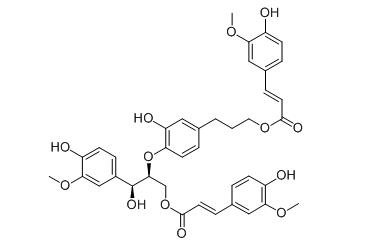Demethylcarolignan E
Demethylcarolignan E is a natural product from Hibiscus taiwanensis.
Inquire / Order:
manager@chemfaces.com
Technical Inquiries:
service@chemfaces.com
Tel:
+86-27-84237783
Fax:
+86-27-84254680
Address:
1 Building, No. 83, CheCheng Rd., Wuhan Economic and Technological Development Zone, Wuhan, Hubei 430056, PRC
Providing storage is as stated on the product vial and the vial is kept tightly sealed, the product can be stored for up to
24 months(2-8C).
Wherever possible, you should prepare and use solutions on the same day. However, if you need to make up stock solutions in advance, we recommend that you store the solution as aliquots in tightly sealed vials at -20C. Generally, these will be useable for up to two weeks. Before use, and prior to opening the vial we recommend that you allow your product to equilibrate to room temperature for at least 1 hour.
Need more advice on solubility, usage and handling? Please email to: service@chemfaces.com
The packaging of the product may have turned upside down during transportation, resulting in the natural compounds adhering to the neck or cap of the vial. take the vial out of its packaging and gently shake to let the compounds fall to the bottom of the vial. for liquid products, centrifuge at 200-500 RPM to gather the liquid at the bottom of the vial. try to avoid loss or contamination during handling.
Research Square2021, March 3rd.
Molecules.2021, 26(9):2791.
Cancers (Basel).2021, 13(17):4327.
Journal of Ginseng Research2021, 25 November
J Nat Med.2020, 74(1):65-75
Molecules.2017, 22(2)
Int J Mol Sci.2023, 24(14):11496.
Konkuk University2023, 29:4634721
Foods.2023, 12(7):1355.
Plants (Basel).2021, 10(7):1376.
Related and Featured Products
Dadahol A
Catalog No: CFN98636
CAS No: 405281-76-7
Price: Inquiry(manager@chemfaces.com)
Demethylcarolignan E
Catalog No: CFN96712
CAS No: 873694-46-3
Price: Inquiry(manager@chemfaces.com)
Caffeic anhydride
Catalog No: CFN92330
CAS No: 854237-32-4
Price: Inquiry(manager@chemfaces.com)
Myrislignan
Catalog No: CFN99752
CAS No: 171485-39-5
Price: $198/20mg
1-(3,4-dimethoxyphenyl)-2-(4-allly-2,6-dimethoxyphenoxy)propan-1-ol
Catalog No: CFN92657
CAS No: 41535-95-9
Price: $238/5mg
Acetylvirolin
Catalog No: CFN96736
CAS No: 916264-22-7
Price: Inquiry(manager@chemfaces.com)
4,9,9'-Trihydroxy-3,3'-dimethoxy-8,4'-oxyneolignan
Catalog No: CFN97728
CAS No: 53505-68-3
Price: Inquiry(manager@chemfaces.com)
erythro-Guaiacylglycerol beta-dihydroconiferyl ether
Catalog No: CFN96719
CAS No: 135820-77-8
Price: Inquiry(manager@chemfaces.com)
4,7,9,9'-Tetrahydroxy-3,3'-dimethoxy-8,4'-oxyneolignan 7-O-beta-D-glucopyranoside
Catalog No: CFN95682
CAS No: 182056-97-9
Price: $368/5mg
Isodonoside II
Catalog No: CFN95730
CAS No: 2095793-37-4
Price: $413/5mg
Bioorg Med Chem. 2004 May 1;12(9):2193-7.
Cytotoxicity of phenylpropanoid esters from the stems of Hibiscus taiwanensis.[Pubmed:
15080919]
METHODS AND RESULTS:
The separation of an extract prepared from the stems of the previously uninvestigated Hibiscus taiwanensis led to the isolation of three new phenylpropanoid esters, (7S,8S)-Demethylcarolignan E (1), hibiscuwanin A (2), hibiscuwanin B (3), in addition to eight known ones. The structures of these compounds were elucidated by spectroscopic and chemical transformation studies.
CONCLUSIONS:
In cytotoxicity evaluation of the isolates, 9,9'-O-feruloyl-(-)-secoisolaricinresinol (8) showed strong cytotoxic activity against human lung carcinoma and breast carcinoma cell lines in an in vitro cytotoxicity assay with EC(50) values of 1.8 and 3.9 microg/mL, respectively.



